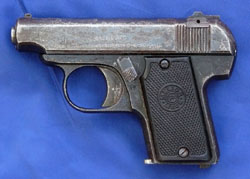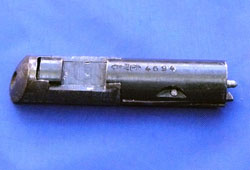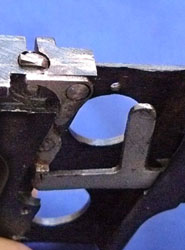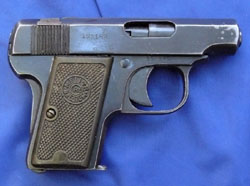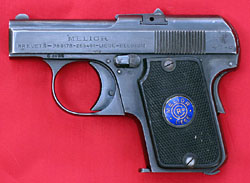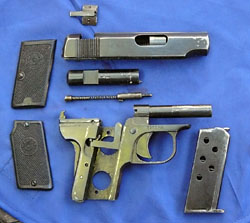 |
|||||||||||||||||||||||||||||||||||||||||||||||||||||||||||||||||||||||||||||||||||||||||||||||||||||||||||||||||||||||||||||||||||||||||||
|
|
|||||||||||||||||||||||||||||||||||||||||||||||||||||||||||||||||||||||||||||||||||||||||||||||||||||||||||||||||||||||||||||||||||||||||||
|
The New Model Melior .25 Caliber Pistol
The design of the New Model is derivative in many of its individual parts, though unique as a whole, and may be of interest to some as a brief chapter in the history of self-loading pistols. My friend Earl Mount has loaned me two guns from his collection which, judging by their serial numbers, are an early and a late version. I also have photographs of guns from the collection of another friend, Stefan Klein. There may be other versions which I have not examined. I have assigned type numbers to the various specimens I have catalogued, based on serial numbers, but I cannot be certain they are in the correct order. Indeed, Matthews, in his book Firearms Identification, Vol. I, indicates that it was the later version of the gun that lacks the grip safety, rather than the early version. But the gun I have examined with the lowest serial number is the one lacking the grip safety. A larger version of the New Model Melior was also made in 7.65mm Browning and, according to Hogg and Weeks, after World War II a .22 caliber and .380 version were also manufactured. If you own a New Model Melior which is in any way distinct from those I describe here, I would greatly appreciate hearing from you.* Type I New Model Melior
The second distinctive feature of the New Model Melior is a captive recoil spring. A bushing at the rear of the spring abuts a cut in the interior of the slide to hold the rear of the spring in place, while a screw-in bushing in the front of the slide retains the front of the spring. The rear bushing also serves to cover the recoil spring in the ejection port and so prevent dirt and grit from getting caught in it--this rear bushing is similar to that on the Walther Model 2, Model 3, Model 4, Model 5, and Model 7. The Melior shares the full slide and concentric recoil spring seen in these Walthers, but the front bushing on the Walther serves as its means of disassembly.
The spring-loaded manual safety on the Melior is just behind and above the trigger on the left side of the gun. It appears to be identical in function to those on the Spanish copies of the 1903 Browning referred to above--it locks the trigger and prevents it from transmitting motion to the sear, but does not lock the sear itself. There is no grip safety and no magazine safety on the Type I. The left side of the slide has a two-line inscription, the first line being in serif characters and the second in sans-serif, as follows: MELIOR I have attempted to locate the patents, but a search of the European Patent Office did not produce any results. The serial number is stamped on the right side of the frame above and slightly in front of the trigger, as well as on the right side of the slide behind the ejection port; it is also stamped on the breech block and many of the small parts of the gun. The serial number of the gun examined is 4694. The usual Belgian proof marks are stamped on the left side of the frame just above the trigger, as well as on the front of the barrel and the top of the breech block. On the left side of the frame, just above the bow of the trigger guard is the caliber designation, 6.35 BR, for 6.35mm Browning. The grips are made of horn, checkered, with an annulus centered toward the top containing the words “Melior” and “Liege” surrounding an “RoC” Monogram in the center. The left grip has a screw at the top and one at the bottom, whereas the right grip has screws at the center rear and at the bottom. The magazine is nickeled, unmarked, has a flat follower, and has 5 holes drilled through each side for viewing the cartridges. The production quality on the gun examined here is not the highest. Faint milling marks are visible on the surface of the frame, and heavy marks are visible on the inside of the grip. Type II New Model Melior
The captive recoil spring is retained, as is the transverse locking piece that links the breech block and the slide and holds the gun together. The breech block continues to be a separate piece which can be removed from the slide. The right side of the grip is not cut all the way to the top of the frame as in the Type I and Type III--hence the grip plates do not extend all the way to the bottom of the slide. I assume that the grips continue to be made of horn. They feature the word MELIOR in a curved oval at the top, beneath which is a TR (or possibly RT) monogram in a circle. The connector or transfer bar that links the trigger to the sear runs on the right side of the gun. It has a transverse pin at its rear end which moves the sear and releases the striker. The disconnector rises up behind the sear, internally, on the right side of the frame--when the slide is out of battery the disconnector is pressed down and moves the connector bar down so it cannot engage the sear. The left side of the slide has a two-line inscription which is identical to that on the Type I, the first line being in serif characters and the second in sans-serif, as follows:
MELIOR The identical gun also appears as the Jieffeco, with the following inscription in upper case sans-serif characters, as follows: PISTOLET AUTOMATIQUE JIEFFECO DEPOSE Matthews likewise lists another identical (or at least similar) gun marked as follows: MRE. LIEGEOISIE D’ARMES Á FEU Type III New Model Melior The next gun I have to examine is serial number 125182, so it is later than the other guns described, if we assume a continuous series of numbers. I’m referring to this gun as the Type III, but there could easily be other models between these types. The Type III retains the separate breech block of the earlier pistosl, but the spring-loaded lever on the dovetailed locking piece no longer serves as the rear sight. Instead there are two raised ridges just in front of the locking piece which are nearly invisible when viewed from behind and hence virtually useless. The captive recoil spring has been retained with no changes. The contour of the rear of the slide has been modified slightly, and the lower edges of the slide are flat instead of machined at an angle.
The piston-shaped sear has been eliminated in favor of a browning-style pivoting sear. A small lever has been added near the top of the magazine well to serve as a magazine safety--this lever blocks the sear until the magazine is almost fully inserted. The gun also features a grip safety which blocks the sear when not depressed. Altogether, this is a more sophisticated and safer pistol than its predecessor. The quality of the machining is much higher than on the earlier gun, with no machine marks visible on the exterior. The interior of the frame is much cleaner as well. The slide inscription on the left side is the same as on the earlier gun, but the word “Melior” is now in sans-serif characters. M E L I O R Belgian proof marks are evident on the slide, frame, and barrel. On the left side of the frame, just above the bow of the trigger guard is the caliber designation, CAL 25. Most small parts are stamped with the last two digits of the serial number. The grips are the same as on the early model, but the right grip is retained by a single screw at the center rear instead of two screws. The magazine is identical to the earlier gun, except it is blued instead of nickeled. Type IV New Model Melior
The Type IV was clearly patterned after the Walther Model 9, which took the vest pocket pistol market by storm when it appeared in 1921. All the world’s major pistol manufacturers wanted a product that could compete with the Walther. The Type IV retains the separate breech block and slide held together by a transverse locking piece, but in the case of the new small pistol the locking piece is moved considerably forward on the slide and the spring-loaded locking lever is reversed so that it points forward and also serves as a top-mounted extractor. Like the Walther, the Type IV Melior has an external connector which runs beneath the grip plate on the right side. An integral disconnector projects upward from the connector at right angles. Also like the Walther, the recoil spring has been moved to beneath the barrel. The Melior has an ejector on the left side made from very thin sheet metal, which is easily broken off. Both the Walther Model 9 and the Type IV Melior have top-mounted extractors and eject the empty shell out the top of the gun rather than to the side. Two significant features of the Type IV New Model Melior are the grip safety and internal hammer. Very few other imitators of the Walther Model 9 have grip safeties, the only one I can think of being the early variant of the MAB Model B. The Melior grip safety does not pop out unless the hammer is cocked, and so serves as a cocking indicator. I have not disassembled the gun so far as to describe the mechanism precisely, but the grip safety appears to block the sear, whereas the manual safety only blocks the trigger, but together the two safeties should make the gun safe to carry with a round in the chamber. To my knowledge, none of the other Model 9 imitators have an internal hammer. One of the problems with the Walther Model 9 is that, if the gun remains cocked for long periods of time, the striker spring becomes compressed and doesn’t function properly. This problem is obviated by having an internal hammer. The grip plates are made of horn. The left plate is checkered and has a circular blue insert, with MELIOR on top and LIEGE at the bottom surrounding the Robar Company monogram in the center. The right grip plate is also checkered with an annulus in the center, MELIOR on the top, BELGIUM on the bottom, and 6.35 in the center. Precise dating is beyond my means, but a 1927 catalogue of the French company Verney-Carron lists only the larger model, specified by its length of 120mm, whereas the 1932 German WUM catalogue lists both guns. (The smaller gun sold for $7.50, whereas the larger New Model sold for $6.00.)
Field Stripping the New Model Melior
*If you can provide photographs, serial number and model information, or any other information about the Melior pistols, please write to me at edbuffaloe@unblinkingeye.com. |
|||||||||||||||||||||||||||||||||||||||||||||||||||||||||||||||||||||||||||||||||||||||||||||||||||||||||||||||||||||||||||||||||||||||||||
|
|||||||||||||||||||||||||||||||||||||||||||||||||||||||||||||||||||||||||||||||||||||||||||||||||||||||||||||||||||||||||||||||||||||||||||
|
Copyright 2011 by Ed Buffaloe. All rights reserved. |
|||||||||||||||||||||||||||||||||||||||||||||||||||||||||||||||||||||||||||||||||||||||||||||||||||||||||||||||||||||||||||||||||||||||||||
|
|
|||||||||||||||||||||||||||||||||||||||||||||||||||||||||||||||||||||||||||||||||||||||||||||||||||||||||||||||||||||||||||||||||||||||||||
|
|
|||||||||||||||||||||||||||||||||||||||||||||||||||||||||||||||||||||||||||||||||||||||||||||||||||||||||||||||||||||||||||||||||||||||||||
